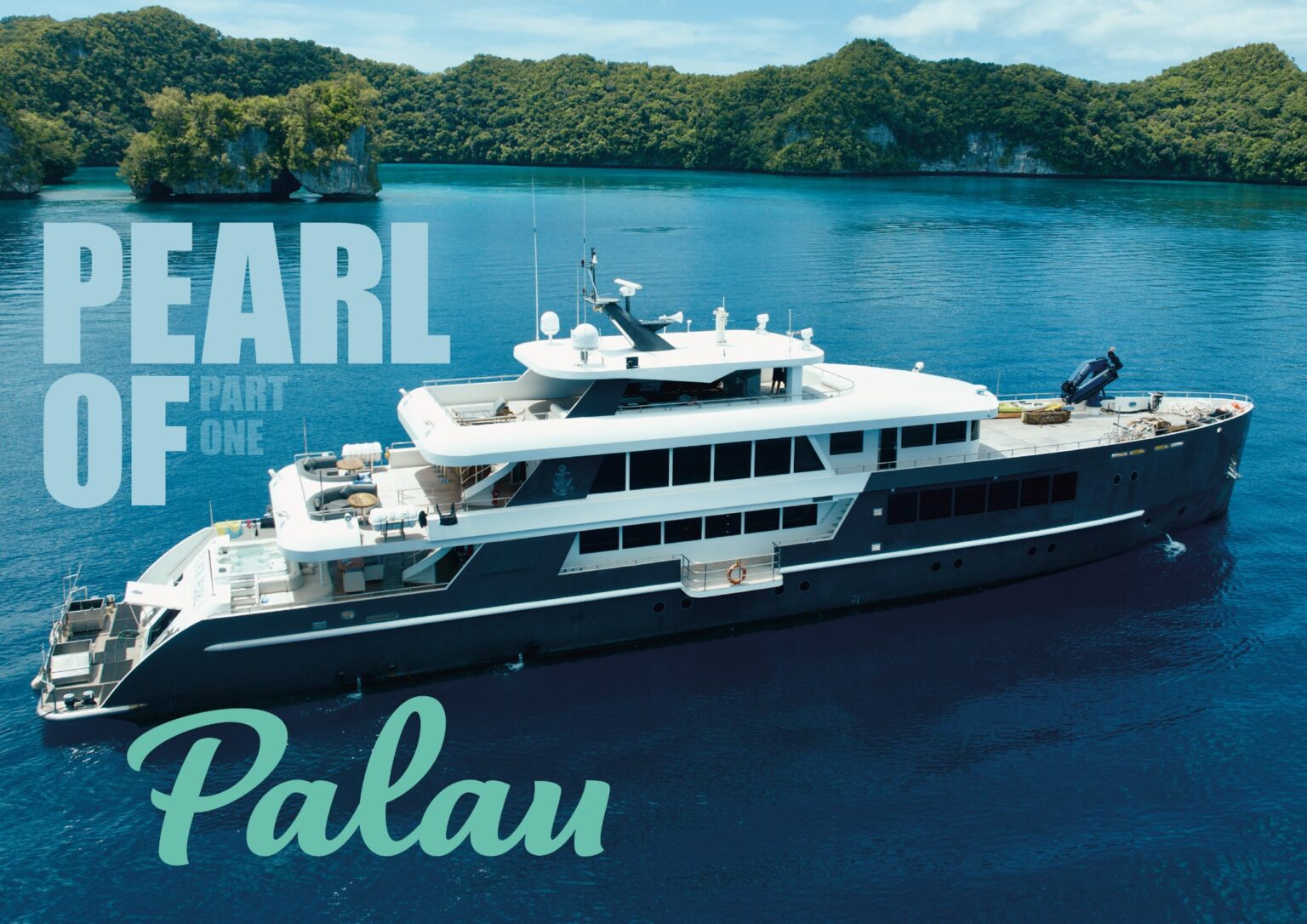Palau had always ranked highly on Adrian Stacey’s bucket list of destinations, and he jumped at the chance to dive there, especially as he’d be aboard a true superyacht in the world of liveaboards – the Black Pearl
Photographs by Adrian Stacey & Gabriel Hermida
The Republic of Palau is a tiny island nation in the west pacific. To its east is the Philippines, and to the south are Indonesia and Papua New Guinea. The archipelago of Palau consists of over 500 beautiful rainforest-covered islands, and it is clear to see that the population of around 20,000 inhabitants take great pride in their nation. The streets are clean, the buildings well maintained, and the public areas are well manicured.
Conservation Efforts and Marine Sanctuaries
Tourism, particularly dive tourism, is one of Palau’s primary sources of income, so it is no surprise that the government has robust environmental and conservation policies.
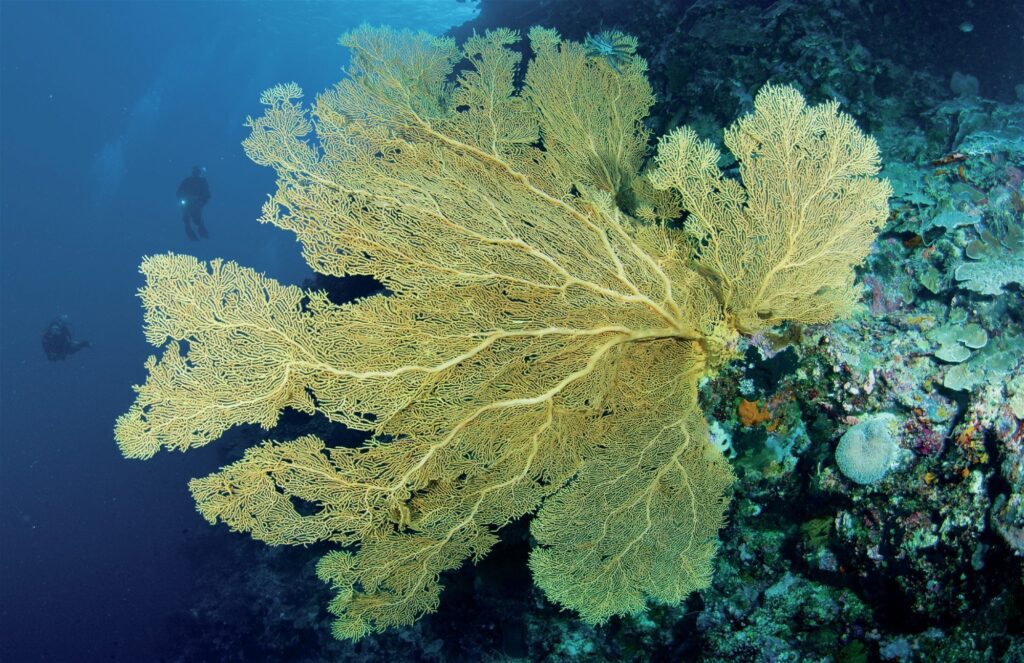
Many of its islands and surrounding seas have protected status, and in 2009, Palau created the world’s first shark sanctuary, banning shark fishing in an area covering approximately 600,000 sq km. The result is lots of sharks, diverse marine life and healthy reefs.
Palau is one of those rare destinations that offers a wealth of outstanding and varied diving, from wrecks to reefs, caves to mangroves and plenty of big animal action, plus unique spawning events that occur regularly.
Dive sites like Blue Corner, the German Channel, and Chandelier Cave are world-famous, and the scenery above the water is spectacular too. It is because of these reasons that Palau is a country that I have wanted to visit for a long time now.
Aboard the Black Pearl
So, when the opportunity to dive here came up, I jumped at the chance to tick this diving wonderland off my bucket list. The icing on the cake was that I would be diving the marvels of Palau onboard what could only be described as a liveaboard superyacht, the Black Pearl.
Bearing no resemblance to the Black Pearl of Pirates of the Caribbean fame, this Black Pearl is a 45-metre beauty of a dive boat that began running trips in Palau in 2019. There are 14 spacious, well-appointed, and air-conditioned cabins, all ensuite with hot water.
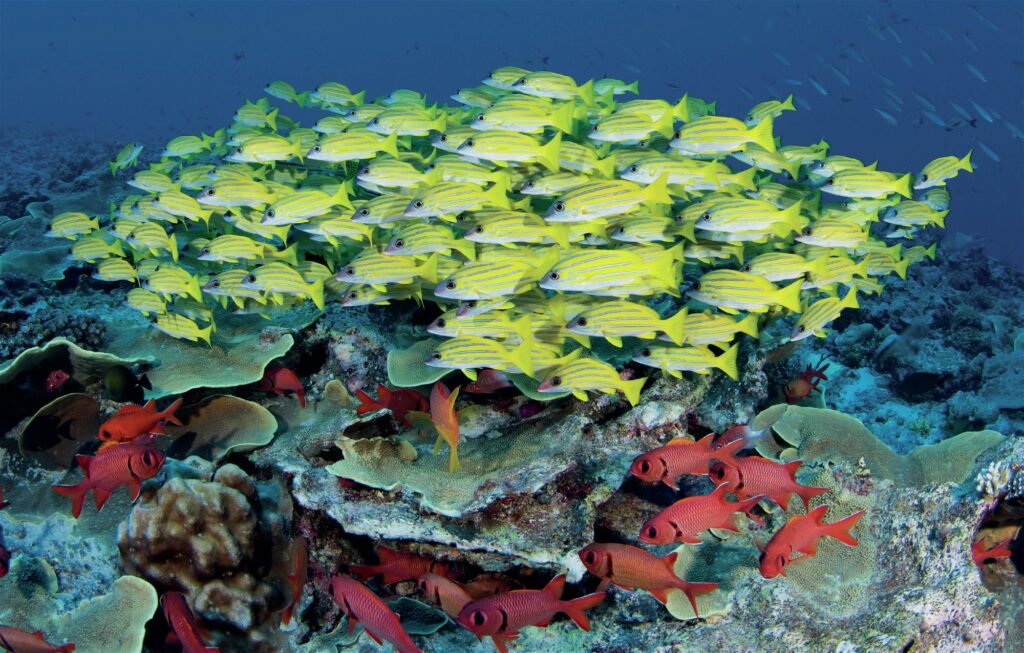
On the lower deck, the dive platform is equipped with two large freshwater rinse tanks for cameras and equipment and freshwater showers for after the dives. Also on this deck is the compressor room and equipment room. Dehumidifiers and fans in the equipment room ensure wetsuits dry overnight, which I thought was a nice touch.
The main deck comes complete with a jacuzzi, comfortable seating, a camera station and a generous wet area where drinks, snacks and dry towels are always available after the dive. Inside is the dining area, where hot drinks and water are always available.
The pilot deck has comfortable alfresco seating and a bar perfect for sunset drinks. This deck also has an indoor lounge with large TVs, plus a camera preparation and charging area. The next level up is a vast sundeck with plenty of space for lounging after a hard day of diving. All in all, the Black Pearl is the height of luxury.
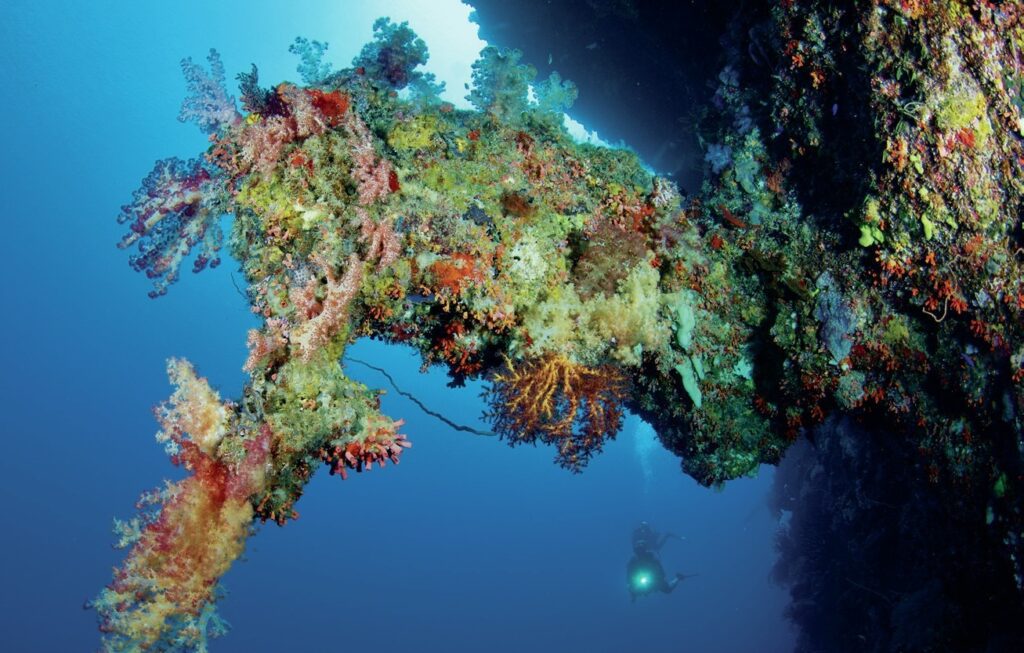
The first day I joined the vessel was a dry day. We were welcomed onboard at around 3pm and, after the grand tour, were given a briefing on the boat and safety features. As is customary at these briefings, we were asked to introduce ourselves and share what we would like to see on this trip with the group.
I was pleased to note that not a single person was eager to search for nudibranchs or other critters – not that I have anything against these colourful little creates or other small inhabitants of the reef, it is just that my preference is for the big stuff, sharks, rays and large schools of fish, plus pristine reefscapes of soft and hard corals.
Having a boat full of divers of a similar mindset bode well for the trip.
Diving Highlights in Southern Palau
The diving for the first half of the trip was in the southern regions of Palau around the island of Peleliu and the German Channel. This shallow man-made channel was carved through the reef in 1909 by the Germans when Palau was a German colony.
The channel connects a sheltered lagoon to the Pacific Ocean. This allowed ships to pass from the Southern islands of Peleliu and Angaur to the main trading port of Koror. It is far too shallow for today’s modern ships to pass through, so dive operators now use it to access some of the outer reef’s dive sites, like the Blue Holes and Blue Corner.
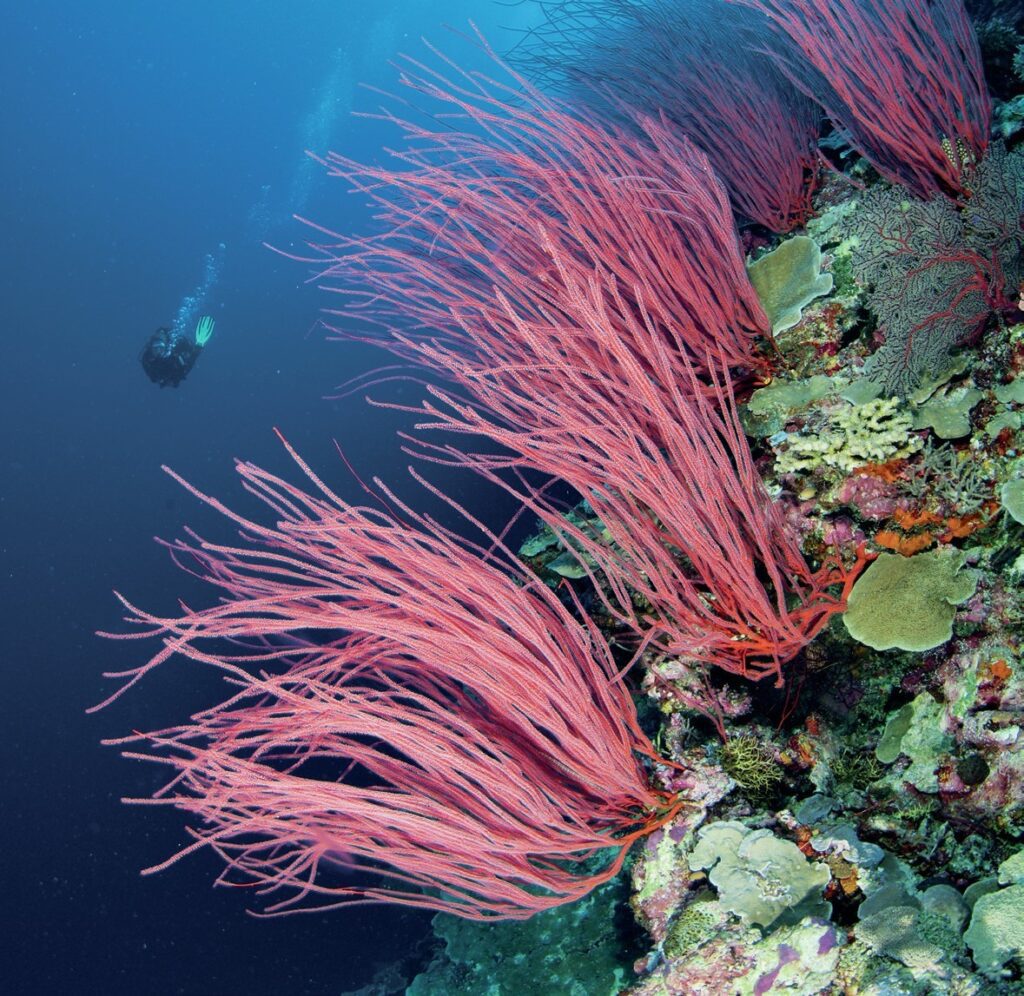
For the first day of diving, our cruise directors, Gabriel and Maria, had a mouth-watering line-up of dives planned for us, which included a couple of the region’s most-famous dive sites.
Our first dive was an enjoyable introduction to diving in Palau with a cruise along Barnum’s Wall, but what I was really looking forward to was the second dive of the day at Blue Corner. This spot is famous for strong currents, walls of fish and plenty of sharks.
Our dive began on a dramatic wall that dropped to over 300m. A massive school of jacks stuck close to the top of the reef as grey reef sharks scythed through their ranks. After swimming along the wall for a few minutes, we arrived at a plateau that juts into the ocean.
This plateau is where the current converges and large congregations of schooling fish usually assemble, attracting sharks and other large predators. We used reef hooks to secure ourselves to the plateau’s edge near the drop and hung in the mild current to watch a procession of sharks, fusiliers, barracuda, tuna, and rainbow runners swim past us.
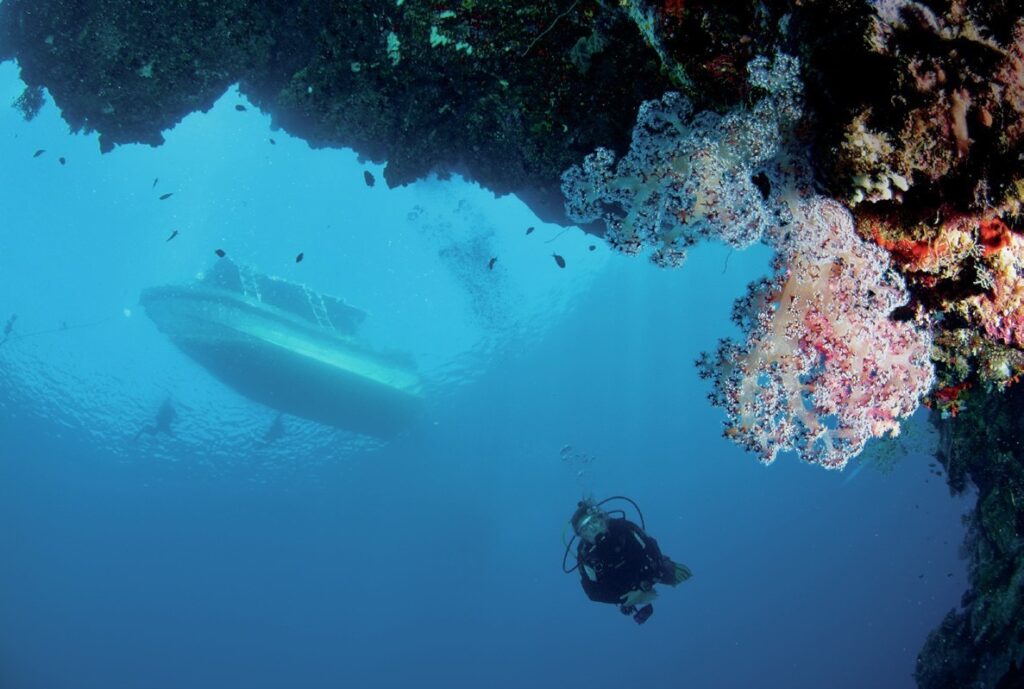
After this spectacle, we explored the plateau, where we found schools of yellow snapper, numerous green turtles, marble grouper, and Napoleon wrasse. Plus, swarms of red tooth triggerfish, pyramid bannerfish and anthias.
While this was a superb dive, I could not help but think that we had not seen Blue Corner at its best and that with a little more current, the fish would have formed into a nice tight ball, and the predators would have been more focused.
After the dive, I asked Gabriel how this dive at Blue Corner rated with some of his other dives at this location. He gave this one a 3 out of 10, confirming my suspicions.
Still, I could see the potential for this site, and a 10 out of 10 here must be absolutely mind-blowing.
The Diversity of German Channel
The final dive of the day was at one of Palau’s other signature dive sites, the German Channel. At the end of the shallow man-made channel, a sloping reef of hard coral descends to around 15m. The hard corals give way to a sandy bottom scattered with coral bommies.
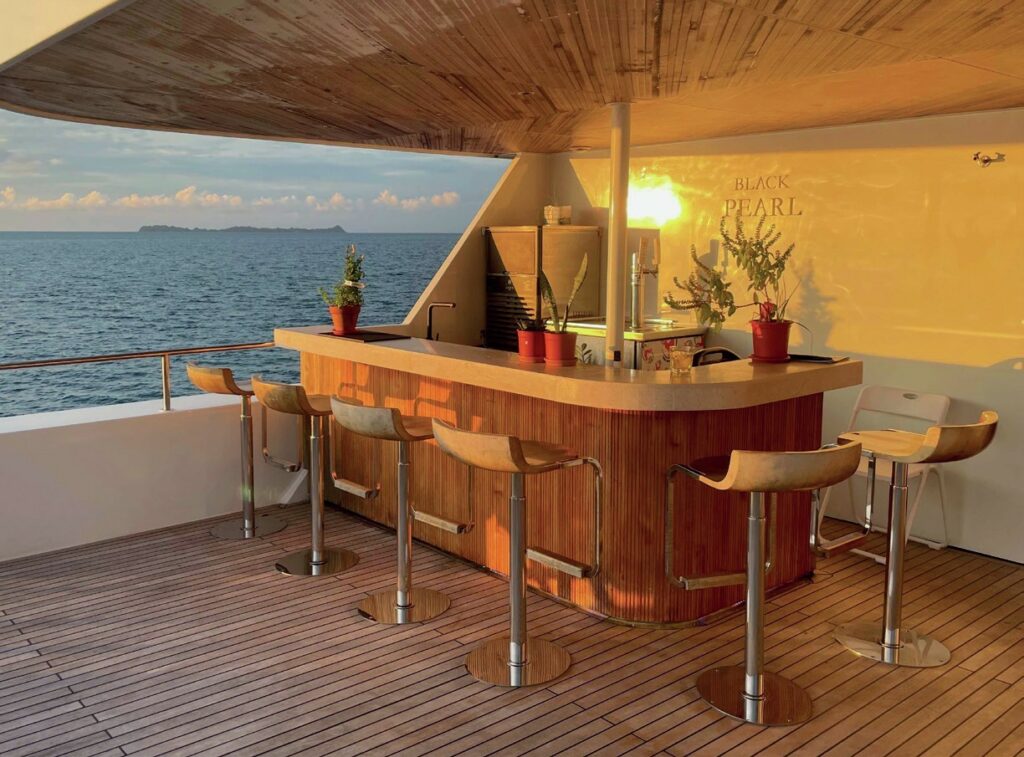
Some of these bommies are cleaning stations that sharks and mantas frequent. Although we were at the end of manta season, we still hoped to encounter some of these majestic creatures.
Unfortunately, no mantas were present on our dive, but we did see some grey reef sharks try to hold still for long enough to get cleaned. Plus, we saw a large father tail ray, school of humpback snapper, juvenile barracuda and lunatail bigeyes.
On the way back to the Black Pearl, we did see two giant mantas cruise through the channel, no doubt on their way to one of the cleaning stations we had just left!
Later that afternoon, our cruise directors Gabriel and Maria organised an excursion to a stunning nearby beach for sunset drinks, which was the perfect way to relax at the end of a great day of diving.
Cultural and Historical Insights
The following morning, we boarded the dive tenders and made our way to the island of Peleliu, where our morning dives would take place. This was about a 30-minute journey from the Black Pearl, so the plan was to have a dive, breakfast on the island, and then dive again before heading back to the mother ship.
The dive tenders are completely covered, spacious and comfortable, and the journey allowed us to enjoy the stunning scenery of a tiny island covered in dense rainforest and shallow crystal-clear lagoons.
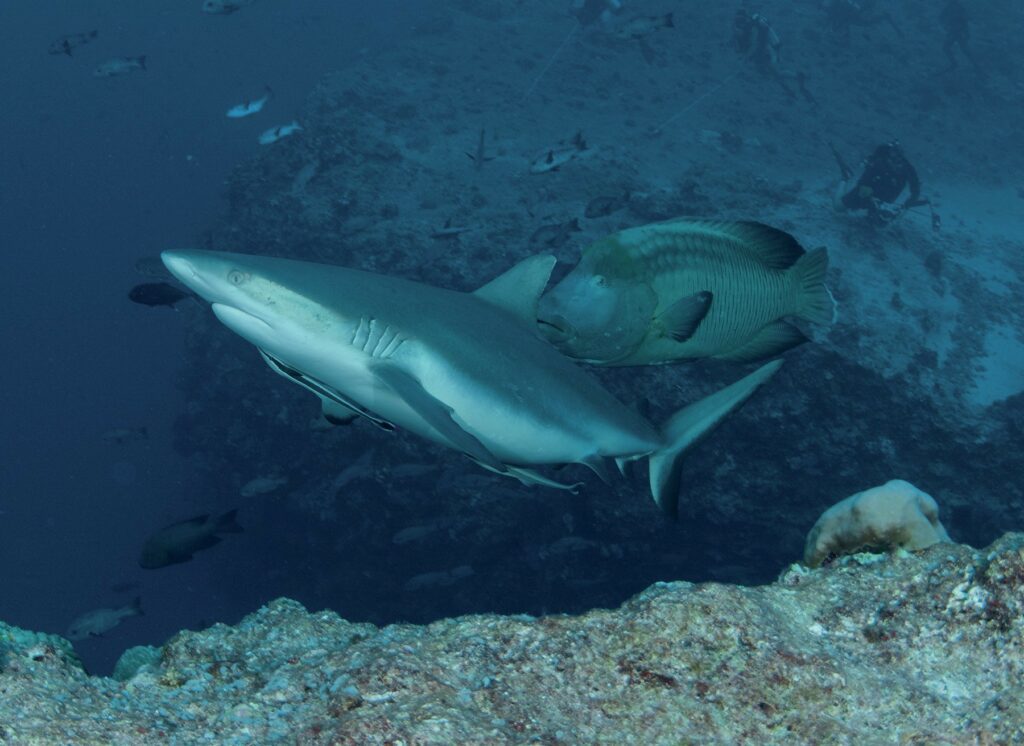
As a bonus, on our way to the dive sites, we encountered a resident pod of dolphins that like to play with any boat that passes through their territory. After our first dive at a site called Orange Beach, we headed to the island of Peleliu for breakfast.
Peleliu was the scene of some fierce fighting in World War Two. Thousands of American and Japanese soldiers lost their lives fighting for the island, and evidence of the battle can still be found in the surrounding jungle.
After breakfast, we dived at Peleliu Cut – this was definitely one for the adrenaline junkies. The ref starts at around 10m on a large plateau which blacktip reef sharks zipped across. A sheer wall then plunges into the depths.
A massive school of jacks hung in the blue just off the reef, and below them, 30-plus grey reef sharks had congregated. A large bull shark also joined this shiver of sharks. Adding to the list of predators that the schools of jacks had attracted were tuna, rainbow runners, trevallies, and mackerel. This was a fantastic dive and one of the trip’s highlights so far.
On the way back to the Black Pearl, we made an unscheduled stop on a beach at the entrance to the German Channel. Some corals are entirely out of the water at low tide, and stopping at this stunning beach was well worth delaying lunch for.
For the final dive of the day, we went back to the German Channel to see if the mantas from the previous day would return. They did! Unfortunately, we once again met them when the dive had finished on the way back to the Black Pearl.
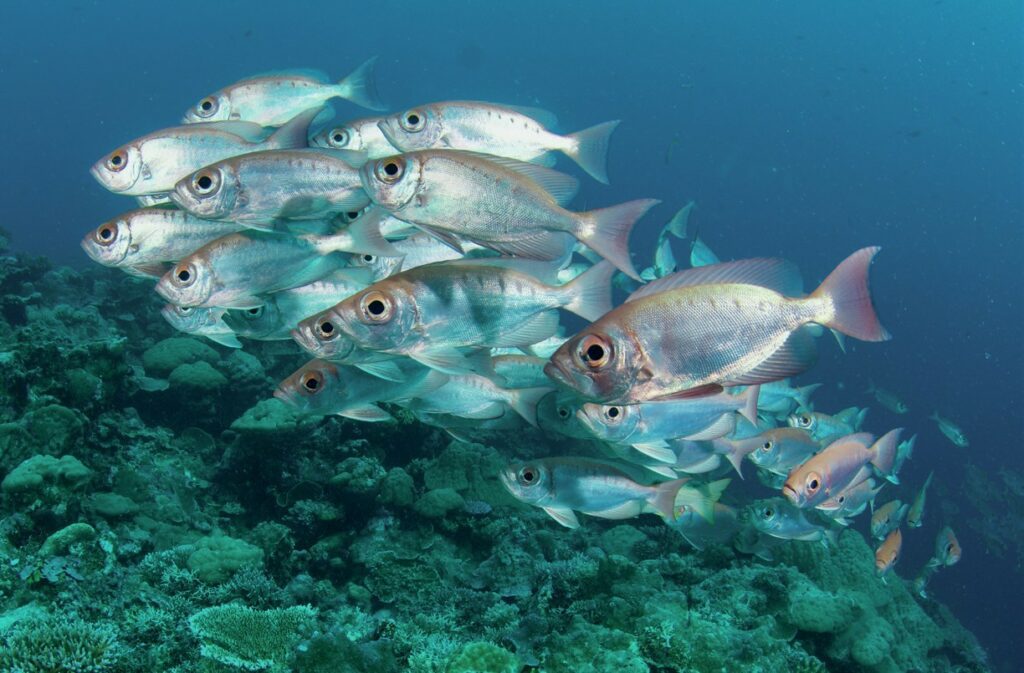
We started the next day with a fantastic dive at the Blue Hole flowed by New Drop Off, which is another of the region’s wall dives that attracts all manner of schooling fish and hungry predators. The third dive of the day was my favourite.
Turtle Cove is a wall dive of epic proportions. Almost every inch of the reef is covered in soft coral, whip corals and sea fans.
Broccoli corals drip off the numerous overhangs and swim-throughs. Like on just about every other dive, there are, of course, sharks, plus turtles, and schools of surgeon fish, snapper and jacks. Towards the end of the dive, there is a large cavern at around 15m where schools of anthias pulse from the reef and a school of blackfin barracuda hung in the blue.
There was a night dive planned for the evening but as I am not particularly fond of night dives I took the opportunity to relax on the upper deck and watch the sun dip below the horizon, painting the sky in a spectacular array of colours.
With three days of diving now completed, only three days were left. So far, the diving had been excellent, and the rest of the week promised more unique experiences and fantastic dives.
This article was originally published in Scuba Diver ANZ #59.
Subscribe digitally and read more great stories like this from anywhere in the world in a mobile-friendly format. Link to the article
